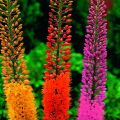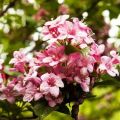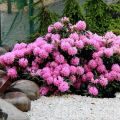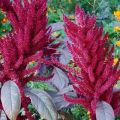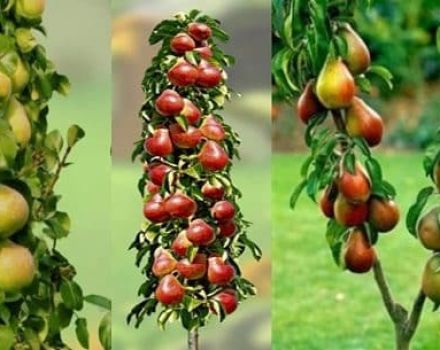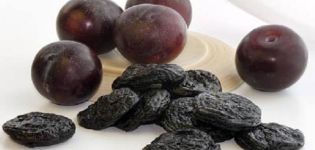Planting and caring for Rogers in the open field, its types and growing rules
Rogersia fell in love with flower growers for its lush foliage and unpretentiousness. An exotic guest does not need an abundance of sunlight, throws a carpet of carved leaves in shady corners, where other plants will wither without bright rays. Consider how to grow Rogers - site selection, planting and care, as well as the use in landscape design and methods of plant propagation.
Description and features
The homeland of Rogersia (Rodgersia) is the eastern part of Asia, the Himalayas. It is a herbaceous perennial with a long taproot. The plant is cultivated because of its beautiful carved leaves - on long petioles, pinnately or finger-shaped, with a pointed end. During the growing season, foliage can change color. Inflorescence - panicle, color of small flowers - from white to red. The bush blooms for 4-6 weeks in mid-summer. Bright flowers against the background of a carpet of foliage look elegant and touching. Belongs to the Kamnelomkov family.
Kinds
Only a few species of Rogers are known, differing in the shape and color of the foliage. All of them are found in nature only in the east of the Asian continent.
Elderberry
Found naturally in China. Rogersia elderflower blooms with white fragrant panicles, reaching a height of 0.5-0.6 meters. The leaves are like elderberry greens.
Chestnut
The foliage of this type of rogers resembles a horse chestnut, a bush, with good care, can grow over a meter. Leaves are deep dark green. Horse-chestnut rogers bloom in mid-summer with white, pink or pink-white panicles.
Plumose
Pink-white inflorescences of Rogersia pinnate grow up to 1.2 meters in height, panicle length is 30 centimeters. Short petioles make the leaves look like palm trees. Many varieties are created on the basis of Rogersia pinnate, they are distinguished by high drought resistance.
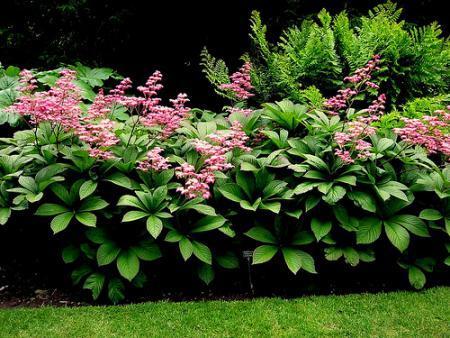
Stoolistnaya
One of the most decorative types of Rogers - the color of the foliage changes from bronze to green, by autumn the bush turns red. Grows up to 1.6 meters. Flowers in cream-colored panicles.
Nepali
The leaves of the Nepalese Rogers sit far apart from each other on long petioles, have a glossy surface and pointed edges. The inflorescences are dense, the color of the petals is yellow-green.
Henrici
Bushes grow up to 0.8 meters. Henrici is a subspecies of the concubine-leaved Rogers. In summer, the foliage becomes bright green, the color of the flowers is pink, cream.

Reference: the name of the beautiful perennial was given by the name of Admiral Rogers (America), whose expedition discovered in China an unfamiliar plant of an impressive appearance.
Popular varieties
The varietal variety of Rogers is impressive. Many varieties show striking changes in foliage color during the season. Those who believe that leaves can only be green will also find Rogers to taste.
Bronze Peacock
Bronze Peacock has structured leaves that change color from bronze brown in spring to dark green in summer. The pink flowers are collected in large inflorescences that rise up to 1.2 meters.
Irish Bronze
Irish Bronze has a bush up to a meter high and wide. Leaves - up to 50 centimeters, on long petioles. They bloom in bronze and gold, then turn green. The flowers change color from cream to white.
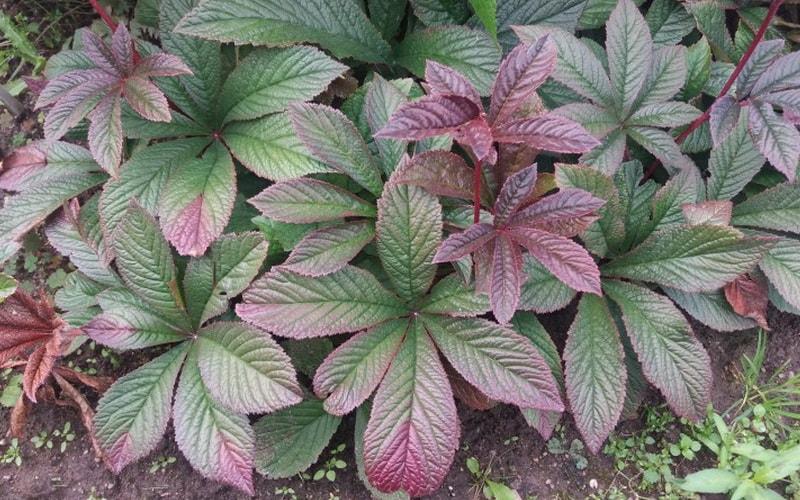
Elegans
The pink-white inflorescences of Elegans rise up to 1.2 meters, the leaves at the beginning of the growing season are purple, gradually turning into rich green.
Dark Poker
Dark Pokers blooms with pink-red small flowers on high peduncles. A brownish-pink border runs along the edge of the green leaves. Withstands frosts down to -29 °, can be planted in any region of Russia.
Superba
The pink Superba panicles will leave no one indifferent. The harvested foliage with spectacular veins takes on a bronze bloom closer to autumn, when the Rogersia fades.

Fireworks
The mauve flowers bloom in late June and early July. All season Rogersia pleases the eye with large exquisite leaves with purple edging.
Hercules
The Hercules variety is distinguished by large expressive leaves (50 centimeters long). Against the background of funnel-shaped foliage, pale pink long panicles of inflorescences look tender.
White
A large perennial is used to create a spectacular landscape gardening. White flowers delight with freshness and charm for a month against the background of impressive leaves.

Chocolite Wings
A popular variety among those who love not only green on the site. The foliage is bronze-chocolate when blooming, it turns green only for flowering. Peduncles with buds of a red-pink hue rise above a meter.
Braunlaub
The Braunlaub variety is unpretentious, growing in the shade and in dim sun. The leaves turn green by the time of flowering, initially the color of milk chocolate. The creamy flowers have a delicate scent.
Emerald
Lovers of green foliage should choose the Smaragd variety, it will delight you with an expressive emerald shade of the bush throughout the season.
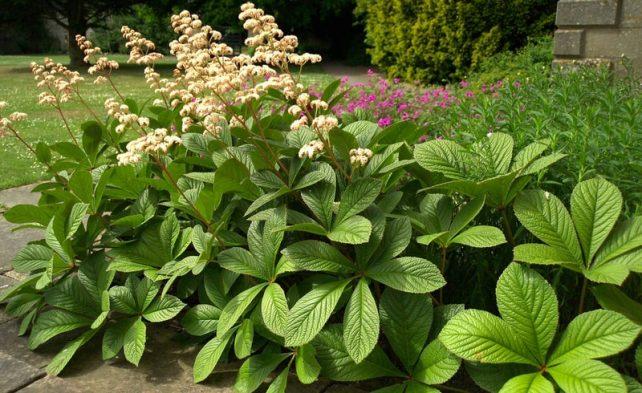
Pagoda
The inflorescences of the Pagode cultivar reminded the breeders of a cult building, which is why the Rogersia got that name. One of the earliest varieties in terms of flowering.
Rotlaub
This Rogersia variety is famous for its spectacular leaf color. If the shrub grows in the sun, the foliage remains bronze brown and reddish all season. In the bushes growing in the shade, the leaves turn green. Flowers retain freshness for a long time, panicles are pinkish-creamy with a pronounced aroma.
Cherry Blausch
The spectacular perennial blooms with pink cherry flowers that bloom in late June. Cherry Blush initially has chocolate foliage, which gradually turns green, and turns red by autumn.

Dee Sean
The inflorescences of the Die Schone Rogers rise above a meter. Against the background of expressive large green foliage with embossed veins, pink flowers look bright and fresh.
Outdoor cultivation
Rogersia is grown by flower growers in Europe and America; our lovers of exotic plants know less about the spectacular perennial. Unpretentiousness and undemanding to sunlight allow growing Rogers in any region.
Seat selection
The selection of a place for the landing of Rogers should be taken seriously - the bush lives for a long time, does not require transplantation. What are considered when choosing a place:
- the bush grows better and looks better in shade conditions;
- the plant has a powerful root system, which is constantly growing, can destroy neighboring plants with a weaker root;
- bushes grow up to 1-1.2 meters in diameter, it is necessary to provide enough space;
- In low-lying areas with high groundwater and frequent puddles, Rogersia root can rot.

Different varieties are advised to plant at a distance from each other, since Rogers can be pollinated. Bushes are planted in places illuminated by diffused rays of the sun 1-3 hours a day - between the fence and buildings, between bushes and trees.
Soil requirements
Rogers requires a light, air and moisture permeable soil with neutral acidity. Heavy clay soils are lightened by woody foliage, compost, humus. The site for planting is dug up in advance, if necessary, it is deoxidized with lime, and complex fertilizers are applied.
Timing
Rogersia takes root well after planting in spring and fall. Things to remember when choosing a term:
- Experienced growers believe that Rogers, planted in autumn, grows quickly in spring. It is important not to plant the bush too late so that the root system has time to get stronger before frost.
- When planting in the spring, you need to wait for stable heat - 5-10 ° at night during the week.
Rogersia is often planted from pots along with the soil, so the plant takes root quickly and without problems.

Landing scheme
The bushes are planted at a distance of 1.2-1.5 meters, trying to place different varieties away from each other. The pit is prepared in advance, focusing on the size of the seedling:
- the bottom is lined with a drainage layer - broken brick, small stones, sand;
- planting soil is prepared - a mixture of compost, humus, foliage, fertile soil, a small layer is poured onto the drainage;
- remove the plant from the pot along with an earthen lump or straighten the roots of an open seedling;
- placed in a hole, deepening by 6-10 centimeters, covered with soil, lightly rammed, watered.
To retain moisture, the soil in the root fossa is mulched with organic matter - foliage, hay, dry grass.
Care
Being in the shade, Rogersia effectively changes the color of the leaves, looks fresh, gives tall peduncles with a large number of fragrant buds. In order for the bush to grow quickly, you need to adhere to the rules of care recommended for the culture.
Watering
An exotic perennial loves moisture, but an overgrown rhizome does not tolerate stagnant water well. When choosing a watering regime, they are guided by the weather characteristics of the season. In dry seasons, watered 2 times a week. If the weather is rainy, check the soil moisture and adjust the Rogers watering pattern.
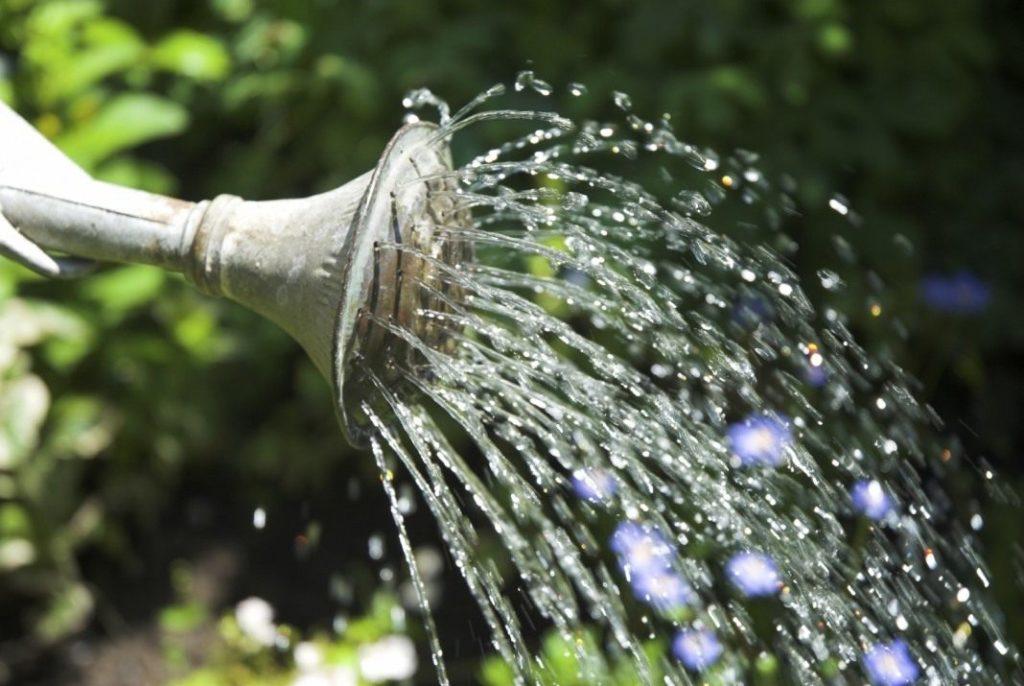
Especially carefully watered bushes growing along water bodies and receiving moisture from the soil. With an excess of water, the vegetation slows down due to decay of the roots.
Reference: The powerful rogersia root is often exposed during watering, you need to immediately cover it with a layer of fertile soil and organic mulch to protect it from drying out and damage.
Pruning
Ornamental pruning is not required for the bushes. Florists are advised to immediately cut out drying and fading leaves so that they do not spoil the appearance of the plant, and in the presence of diseases or pests, they do not infect the entire bush. If seeds are not needed, the drying stalks are cut off immediately after wilting so that they do not stick out with dry sticks over the greenery. If necessary, only 1-2 peduncles are left to obtain seed.
Top dressing
In spring and autumn, the bushes are fertilized with organic matter, if not, nitrogen fertilizers are applied to ensure the growth of green mass. Manure or bird droppings are infused in water for 10-14 days, then diluted with water and fed to the bush during watering.Rogersia needs complex fertilizing containing sulfur, iron, magnesium, zinc, which will ensure flowering. You can use organic fertilizers for flowering plants, which also contain potassium and phosphorus. 2-3 dressings are carried out per season.

Mulching
Mulch serves to retain moisture at the roots, reducing the need for watering. The root circle of Rogers is mulched with organic matter (hay, sunflower husk), which will later become a fertilizer.
Reference: a thick layer of mulch is used to protect the rhizomes from freezing in winter.
Preparing for winter
Most Rogers varieties are renowned for their enviable frost resistance. To reliably keep the plant from freezing, you must:
- Before the frost begins, cut off the green part at the root. This will make wintering easier in any region.
- Water the bush thoroughly. Pour in 1-3 buckets of water, depending on the moisture content of the soil.
- Cover the soil around the bush with a thick layer of mulch.
- In cold regions (Siberia, northern regions, the Urals), use additional insulation.
With the arrival of spring, the covering material is removed in order to prevent the roots from drying out and decay, to ensure natural ventilation and drying out of the soil. The old mulch is removed or dug up, turning it into fertilizer.

Diseases and pests
In the rainy year and in the lowlands, Rogersia suffers from fungal diseases. Despite the resistance of the crop to diseases and pests, with an excess of moisture on the bushes, rust fungus, snails and slugs, choosing plants in shaded places, can appear.
Rot can be identified by yellowing and death of leaves, dark spots, slowing growth rates. A bush affected by root rot is dug out, the diseased areas of the rhizome are cut out without pity, treated with fungicides, and transplanted. Pests are fought by mechanical, folk (dry mustard) methods or chemicals ("Thunderstorm").
Reproduction
Rogersia reproduces in all traditional ways. Most gardeners prefer vegetative ones, since it will take a long time to wait for the result during seed reproduction, varietal properties are not transferred.

Dividing the bush
A part of a horizontally located root is dug out of the soil. Divide it into pieces (about 10 centimeters) with 2-3 buds. In the spring, pieces of the root can be planted in the soil, in the fall, the cuttings are planted in containers and grown at home. Plants are provided with regular watering and feeding.
Cuttings
The role of the cutting in the reproduction of Rogers is played by a leaf with a petiole. It is cut off, placed in an aqueous solution of a root stimulator for several hours. Then they are transferred to a nutrient substrate until strong roots appear. Maintain soil moisture, temperature 15-18 °.
Seeds
Before planting, the seeds are hardened - wrapped in a damp cloth, kept in the refrigerator for 2 weeks. Seed planting time is the end of February. Hardened seeds are sown in a nutritious soil, carefully placed over the soil surface. Lightly dust with dry soil, moisten with a spray bottle. The container is covered with glass, humidity and constant temperature (18-20 °) are maintained. After the emergence of seedlings, they are fed. When several leaves appear, they are transplanted into individual containers for growing.
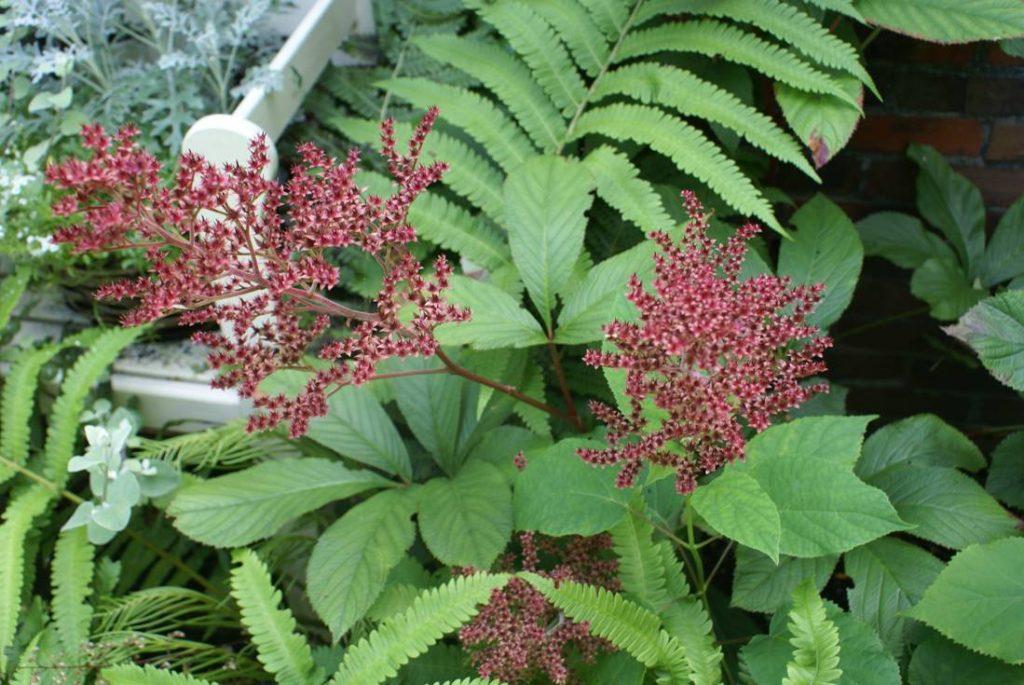
Use in landscape design
With the help of Rogers, you can green shaded areas, giving the garden an exotic flavor and charm. Changing the color of the leaves noticeably changes the appearance of the bushes, the flowers, although they do not differ in particular decorativeness, adorn plants for 4-6 weeks. Rogers are planted next to bells, delphiniums, ferns. Delicate irises, daffodils win next to the abundant green of the bushes. Powerful foliage looks great against the background of conifers, juniper. Rogersia decorate rockeries, complex flower beds, rocky gardens. It is believed that the bush is in harmony with most plants, but it is also used for solitary plantings.
Why does not it bloom and grow
Rogersia needs fertile soil, rich in trace elements - zinc, phosphorus, copper, sulfur. Let's note some of the nuances of leaving:
- The green mass grows poorly with a lack of nitrogen in the soil. Rogersia weakly grows foliage, the bush does not increase in size. It is required to apply nitrogen fertilizers to the soil.
- With a lack of nutrients, flower buds do not form, the peduncle is not formed or weakened. Excess nitrogen fertilization results in overgrowth of greenery at the expense of flowering. To stimulate flowering, Rogers should be fertilized in May-June with potash and phosphorus fertilizers, growth regulators.
Lack of moisture, irregular watering negatively affect the formation of flower buds. If Rogersia constantly receives less moisture, the leaves fall off, do not grow to the usual varietal size, peduncles are not laid.
Rogersia has an unpretentious disposition, the bush grows in one place for up to 10 years. Large bushes with carved leaves that change color, tolerate shade. Rogers are grown in areas with a large number of trees, in corners where sun-loving flowers cannot survive. The exquisite perennial is gradually winning the hearts of Russian flower growers.


